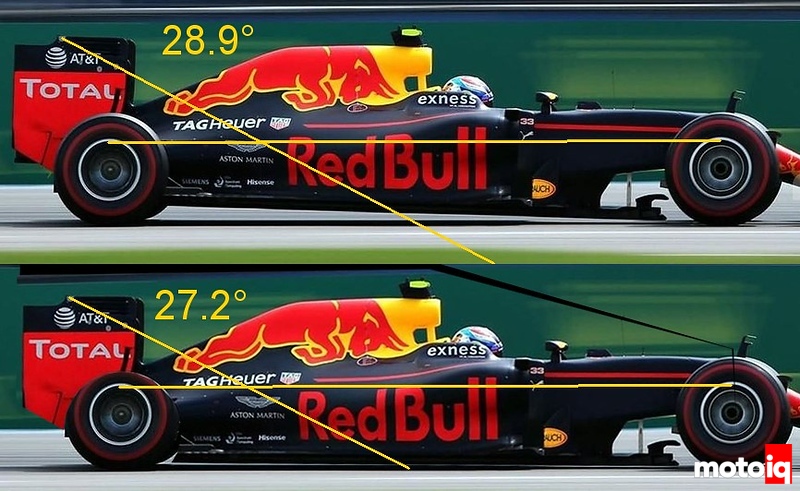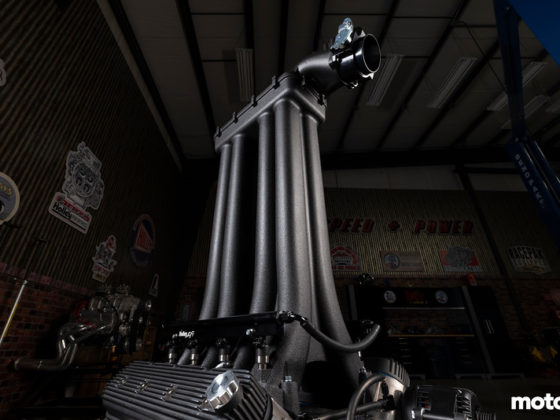It is easy to see from a map like that just how irrelevant and limiting a single value for downforce or drag can be. Aside from the huge variance across speed ranges, you could pick a number for downforce at some ride height you would never see in a corner (where downforce is helping you go quicker) or at some wing angle that would make you under-steer straight off the track. Asking the downforce of the car is like asking what is the altitude of Europe? Are you in the Swiss Alps or on a Mediterranean beach? The question needs important context for a correct and relevant answer. The most basic tool of all is the ride/pitch aero map and you need a graph like this for front and rear downforce as well as drag. These are a must-have to ensure proper and safe development. Enabling teams to maximize aerodynamic force interaction with the suspension, as you see above, is a big deal.
If you want a picture of the severity and extremity of aerodynamic behaviors against sensitivities blow-overs can paint a clear picture. This modern Toyota prototype gains enough lift through a yaw sensitivity to pick the car up off the ground when otherwise in a straight line it would have many tonnes of downforce at speed (as its designers had intended):
Or the infamous back-flips of the Mercedes and Porsche GT1 cars when flat floors were first regulated in the 90s. This is extreme pitch sensitivity.
Tunnels are far safer than diffusers in this regard as flat floors suffer from much higher pitch sensitivity than tunnels. A tunnel car can see larger negative pitch angles before lift is achieved. From this perspective, a tunnel may even be considered a safety device when compared with a flat floor. It also offers a cleaner wake to promote exciting racing by lessening aerodynamic losses to the car following behind.
In reality, when cornering your car will be experiencing several degrees of freedom. In roll, what is the ride height when the outside edge of the splitter is on the ground and the side facing inside the corner is lifted higher than static ride height? Or yaw – where cars are sliding at significant angles any time you are cornering. The steering angle is another major variable. For simplicity in this article, we will focus on ride height/pitch and save yaw, steer and roll for another time.
Diffuser cars also porpoise.
Any underbody device can be prone to porpoising. It is just a question of ride height, if you see a drop in downforce through the ranges it will experience on the track. Any car with sufficient downforce and speed can do this.
With a diffuser car, the contribution to total downforce is less, so the reduction in tire effect on the underbody can work for or against you depending on the design. F1 had its fair share of issues in the early flat floor /diffuser days, some of which weren’t resolved for a much longer time than we see teams sorting porpoising out this year. The lessons learned contributed to the modern level of safety with the rate of driver injuries and deaths trending downward over time. The porpoising seen this year is a relatively mild phenomenon resulting only in reduced lap time and (possibly) driver discomfort; drivers can simply reduce speed when it starts. The sudden behavior of something like a blow-over/vehicle flip will be completely unstoppable. Understanding has advanced much and problems like this have become increasingly rare and less severe.
What is happening under the hood?
A modern ‘venturi’ style tunnel can be imagined as three components: the volume reducing throat section, followed by the minimum diameter nozzle section, and lastly the expanding diffuser section. Porpoising likely begins late in the nozzle or diffuser where flow velocities are higher and adverse pressure gradients can easily lead to flows abruptly detaching from the diffuser wall: the velocity through the tunnel will then be reduced, underbody surface pressure rise, and downforce drops off sharply.
Many of the explanations of porpoising causes are simplified, some citing “less effective” floor sealing vortices as the culprit however in reality while that is not necessarily untrue, flows around any part of the car (particularly underbody surfaces) will be optimized for some ride height and is likely to lose downforce at other ride heights.




13 comments
Brilliant article and interesting insight. Thank you for writing this!
His name isn’t Brilliant for nothing!
Name is one thing, his deeds and expertise are quite another 🙂
The other key issue was from a regulation standpoint. This case is not something that could be tested in the wind tunnel due to a regulatory speed limit for wind tunnel measurements.
Quote from Mattia Binotto: “Honestly, such behavior is normal with this type of car. And it cannot be simulated in the wind tunnel because it occurs at 250-270kph and the regulations limit the wind tunnel speed to 180kph.”
This therefore leaves only the CFD simulation and physical track testing paths for determining whether this issue exists, and gathering the data necessary to understand it.
The article touched on the regulation of wind tunnel speed and scale though maybe did not explain what was to do with the regulations.
Great article. Thank you for taking the time to write it for us.
Pretty certain that the current problems with porpoising has more to do with the ban on inerters for 2022. That coupled with the switch to 18” wheels (stiffer sidewalls increasing suspension frequency) probably has had an extra hand in exacerbating the issue.
“Unofficial proposals were flying around the paddock at Barcelona testing about introducing active suspension and the return of hydraulicly managed suspension and inerters, which dampen out certain frequency moments in suspension to fix porpoising. Formula 1 banned hydraulicly managed suspension and inerters in favour of traditional springs and dampers for 2022. These were highlighted as easy fixes to solve the porpoising issues if the FIA would allow this technology to return to the cars.”
https://www.racecar-engineering.com/articles/formula-1s-porpoising-problem/
That’s more like a cure for the problem, the cause of the problem is covered by Andrew here.
I guess that you didn’t read the linked article. I don’t believe that Andrew actually understands why this issue suddenly became a problem across all cars in 2022. Therefore, Andrew is talking about an aero solution to a mechanical problem, which *might* be possible, but is not a good method of problem solving.
“Porpoising is an issue on most 2022 #F1 cars.
Red Bull have found their solution in a very clever & legal suspension innovation. So they can now run super close to the track. With gas springs and inerters banned, they’ve exploited a non-newtonian fluid filled damper.”
https://mobile.twitter.com/ScarbsTech/status/1509809156521443341
He is talking about an aero problem and to me it’s pretty obvious that it is. I sort of think that careful tuning of the damper’s high-speed circuits would probably work better than non-Newtonian fluid which would work only in a narrow range.
Joe, you should note that at the end of Scarbs’ Twitter thread, he used #April1, and also he’s quoted the suspension engineer as calling the technology something that would shorten to an acronym of PIE, while making repeated references to custard.
I think you’ve missed the joke there…
Hahaha, the joke is way at the bottom of the thread!
Ground effect wasn’t discovered by accident, Peter Wright had been working on airfoil shaped side pods since the late 1960’s and designed a car for March with wing shaped side fuel tanks a few years later before joining Lotus.